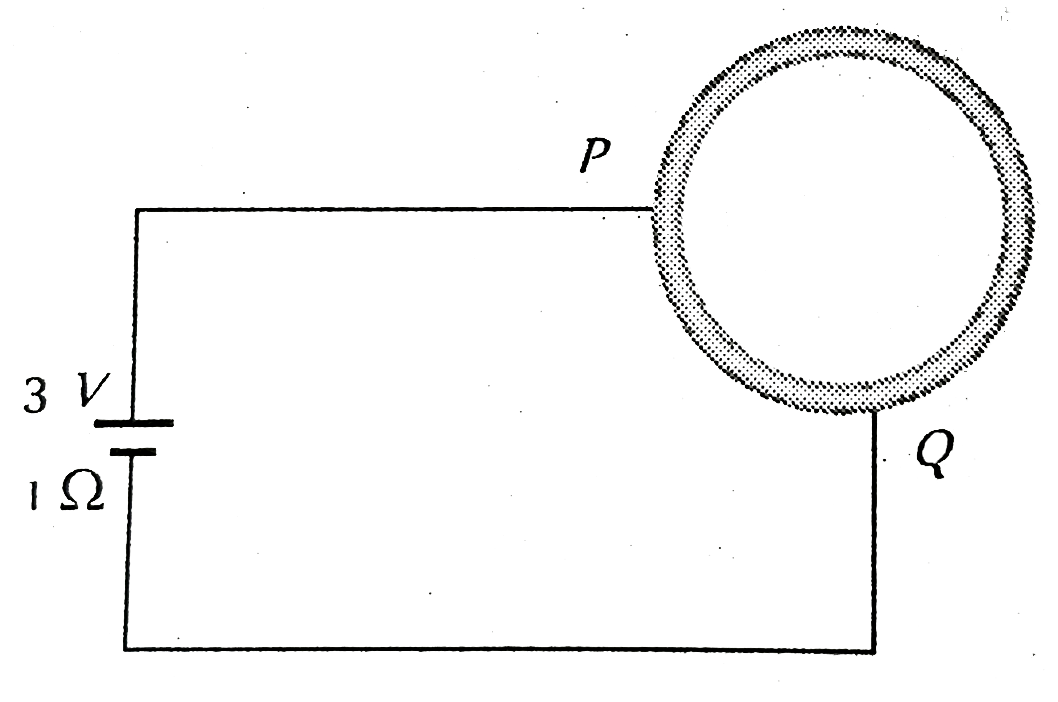A certain length of a uniform wire of resistance 12Ω is bent into a circle and two points, a quarter of circumference apart, are connected to a battery of emf 4 V and internal resistance 1Ω. Find the current in the different parts of the circuit.
The correct Answer is:1213A,(4)/(13)A
To solve the problem step by step, we will follow these steps:
Step 1: Understand the Configuration
We have a uniform wire of resistance R=12Ω bent into a circle. When bent into a circle, the total resistance remains the same, but we can analyze the circuit based on the segments created.
Step 2: Determine the Resistance of Each Segment
Since the wire is bent into a circle, the circumference is divided into four equal parts. The resistance of each quarter circumference (arc) can be calculated as follows:
Rquarter=R4=12Ω4=3Ω
Thus, the resistance between points A and B (which are a quarter circumference apart) is 3Ω.
Step 3: Calculate the Resistance of the Remaining Wire
The remaining part of the wire, which is three-quarters of the circumference, will have a resistance:
Rremaining=R−Rquarter=12Ω−3Ω=9Ω
Step 4: Analyze the Circuit
The circuit consists of:
- A 3Ω resistance (between points A and B)
- A 9Ω resistance (the remaining part of the wire)
- A battery with an EMF of 4V and an internal resistance of 1Ω
Step 5: Find the Equivalent Resistance
The 3Ω and 9Ω resistances are in parallel. The equivalent resistance Req of two resistors in parallel is given by:
1Req=1R1+1R2=13+19
Calculating this gives:
1Req=3+19=49⟹Req=94Ω
Step 6: Add Internal Resistance
Now, we add the internal resistance of the battery:
Rtotal=Req+Rinternal=94+1=94+44=134Ω
Step 7: Calculate the Total Current
Using Ohm's law V=IR, we can find the total current I flowing through the circuit:
I=VRtotal=4V134Ω=4×413=1613A
Step 8: Calculate the Current in Each Segment
Using the current division rule, we can find the current through each resistor:
1. For the 3Ω resistor (let's call the current through it I1):
I1=I⋅RremainingRquarter+Rremaining=1613⋅93+9=1613⋅912=1213A
2. For the 9Ω resistor (let's call the current through it I2):
I2=I−I1=1613−1213=413A
Final Answers
- Current through the 3Ω resistor I1=1213A
- Current through the 9Ω resistor I2=413A
---
We have a uniform wire of resistance R=12Ω bent into a circle. When bent into a circle, the total resistance remains the same, but we can analyze the circuit based on the segments created.
Since the wire is bent into a circle, the circumference is divided into four equal parts. The resistance of each quarter circumference (arc) can be calculated as follows:
Rquarter=R4=12Ω4=3Ω
Thus, the resistance between points A and B (which are a quarter circumference apart) is 3Ω.
The remaining part of the wire, which is three-quarters of the circumference, will have a resistance:
Rremaining=R−Rquarter=12Ω−3Ω=9Ω
The circuit consists of:
- A 3Ω resistance (between points A and B)
- A 9Ω resistance (the remaining part of the wire)
- A battery with an EMF of 4V and an internal resistance of 1Ω
The 3Ω and 9Ω resistances are in parallel. The equivalent resistance Req of two resistors in parallel is given by:
1Req=1R1+1R2=13+19
Calculating this gives:
1Req=3+19=49⟹Req=94Ω
Now, we add the internal resistance of the battery:
Rtotal=Req+Rinternal=94+1=94+44=134Ω
Using Ohm's law V=IR, we can find the total current I flowing through the circuit:
I=VRtotal=4V134Ω=4×413=1613A
Using the current division rule, we can find the current through each resistor:
1. For the 3Ω resistor (let's call the current through it I1):
I1=I⋅RremainingRquarter+Rremaining=1613⋅93+9=1613⋅912=1213A
2. For the 9Ω resistor (let's call the current through it I2):
I2=I−I1=1613−1213=413A
- Current through the 3Ω resistor I1=1213A
- Current through the 9Ω resistor I2=413A
Similar Questions
A bulb of resistance 5Ω is connected to a battery of emf 4.2 V and internal resistance 1Ω. Find the current through the bulb.
View SolutionIn the shown circuit the following battery is of emf 4V and internal resistance 8Ω. Find the potential difference between points x and y as shown in the circuit.

View Solution
Knowledge Check
A wire of resistance 10Ω is bent to form a circle. P and Q are points on the circumference of the circle dividing it into a quadrant and are connected to a Battery of 3 V and internal resistance 1Ω as shown in the figure. The currents in the two parts of the circle are
 A623A and 1823AB526A and 1526AC425A and 1225AD325A and 925A
A623A and 1823AB526A and 1526AC425A and 1225AD325A and 925AA circular coil has a resistance of 40Ω. Two points P and Q of the coil, which are one quarter of the circumference apart are connected to a 16 V battery, having an internal resistance of 0.5Ω ? What is the main current flowing in the circuit ?
A0.5 AB1AC2AD3Atwo heading coils of resistances 10Ωand20Ω are connected in parallel and connected to a battery of emf 12 V and internal resistance 1Ω Thele power consumed by the n are in the ratio
A1:4B1:3C2:1D4:1
A 10 m long potentiometery wire has a resistance of 20Ω it is connected to a battery of emf 6 V and internal resistance 4Ω find the potential gradient along the wire.
View SolutionA battery of emf 2V and internal resistance 0.5(Ω)is connected across a resistance in 1 second?
View SolutionA resistor is connected to a battery of emf 10 V and internal resistance 0.3Ω. What is the resistance of the resistor to be inserted in the circuit for the circuit current 1.2A?
View SolutionTwo resistors of resistances 2Ω and 6Ω are connected in parallel. This combination is then connected to a battery of emf 2 V and internal resistance 0.5Ω. What is the current flowing thrpough the battery ?
View SolutionTwo heating coils of resistance 10Ωand20Ω are connected in parallel and connected to a battery of emf 12V and internal resistance 1Ω. The power consumed by them is in the ratio
View Solution

